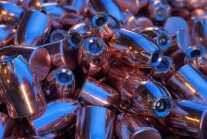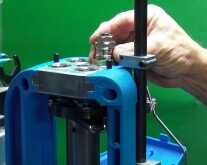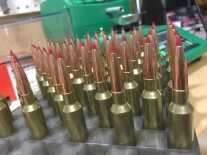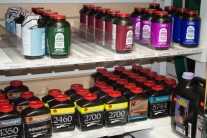Estimated reading time: 11 minutes I intend to get the bullet into the barrel within 10 seconds, for heaven’s sake! Not the whole process of reloading. And honestly on the video, it took me 15. But compare that to a plastic dump tube muzzleloader reload kit that you would buy at Walmart or Cabela’s. This [...]
Reloading Guide
Show First
10 Second Muzzleloader Reload! – Answer to “The Second Shot”
Published: September 16, 2023 { 4 comments }Bullets Matter in Handgun Accuracy – RMR’s 9mm 124 JHP MPR (.3555”)
Published: July 6, 2019 { 13 comments }With great ammo, you can turn a $400 handgun into one that shoots as well as a gun that costs many thousands. The opposite is true as well. Sometimes cheap ammo can turn a handgun that cost many thousands of dollars into one that shoots about as well as a cheap one.
Dillon 550 Conversion Kit – Walking Through the Setup
Published: June 15, 2019 { 3 comments }Getting a new reloading press is a pretty exciting thing! And there is so much to do – from finding the right work area and getting the machine assembled, to deciding what caliber(s) you want to start making. If you are new to handloading then there is also the overwhelming nature of the complexity of the task and the volumes of information to sift through. We’ve all been there!
Maximize Your Accuracy with the RCBS Competition Die Set
Published: April 19, 2019 { 3 comments }Scroll through any forum for ammunition reloaders, and you’ll often see the same advice for newbies: start small. Don’t buy an expensive die set until you know how to use a basic set from Lee or Hornady. This is good advice, generally speaking, but if you buy basic now and then decide to upgrade later, your final bill will be even higher. That’s why I was drawn to the Competition die set from RCBS.
Powder Measuring Redefined: The Revolutionary AutoTrickler V2 & AutoThrow Powder Dispenser Review
Published: September 15, 2018 { 4 comments }This review is intended to give you an overview of what the AutoTrickler V2 & AutoThrow Powder Measure/Dispenser is, what it does, my experience with it, and why it’s quickly becoming the most popular powder measuring/throwing device in the precision shooting world.
Reloading: Final Inspection and Packaging Tips
Published: June 2, 2017 { 0 comments }The very last step in the reloading process is inspection and packaging. After all is done, I like to combine the inspection and packaging steps. As I put each completed cartridge into a box, I look it over to make sure everything is in order.
Reloading: To Crimp or Not to Crimp, That is the Question
Published: May 22, 2017 { 37 comments }Crimping gets a bad rap. Just as we sometimes tend to fix construction mistakes with a hammer rather than taking the time to properly fit parts, we tend to view crimping as a way to “fix” a less than perfect bullet seating. The problem with crimping is that it sounds so logical. The word “crimping” kind of implies the process of locking a bullet in place. But, there is more to it than just that.
Reloading: Seating and Crimping Bullets
Published: March 31, 2017 { 13 comments }So, let’s discuss the topic of seating and crimping in the reloading process. Stated simply, the seating step simply means jamming a new bullet into a cleaned, resized, primed, and powder-charged cartridge case. Crimping “generally” refers to the act of bringing the neck of the cartridge case back to proper dimension after that bullet is stuffed in. There’s a lot more to both actions, especially if you want to be safe, so let’s take a closer look at both steps.
Reloading: Bullet Materials and Shapes
Published: February 3, 2017 { 13 comments }Bullets are bullets, right? Well, not really. There are a wide array of variables in bullet shape, weight, materials, and construction. Each of these variables can have a dramatic impact on the performance, and safety, of any given load. In other words, loading recipe data for one 147-grain, .308 bullet may be incorrect, and even unsafe, for another projectile of equal caliber and weight. Let’s take a closer look at some of the variables and what you need to know about each.
Reloading: Powder, Propellants, and Pressure
Published: June 24, 2016 { 15 comments }When it comes to reloading, the powder is the biggest variable. Not only do you need to worry about the exact amount of powder in a charge, you also need to consider the type of powder. By my rough count, and this is not at all official, there are somewhere around 150 types of powder on the market.









